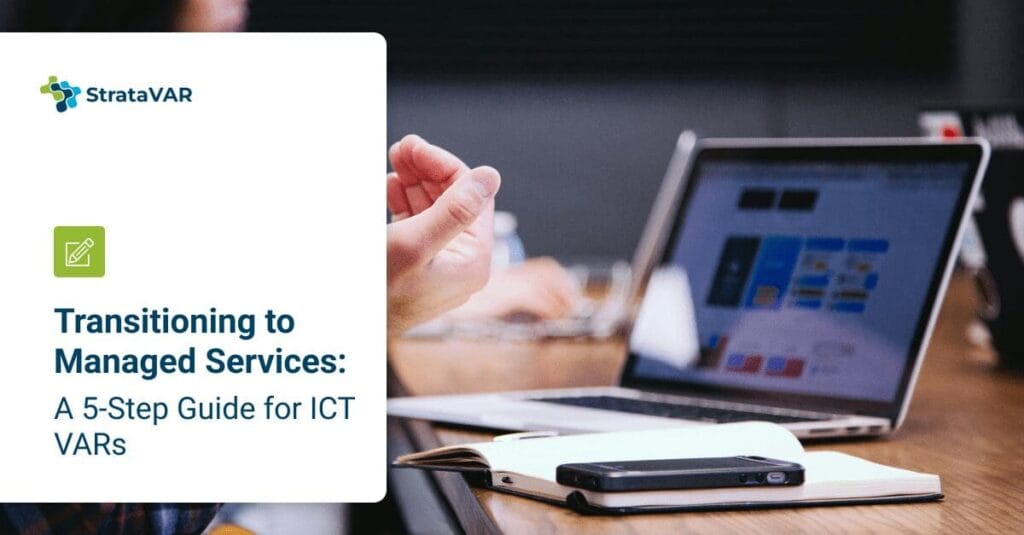
In recent years we see ICT Value-Added Resellers (VARs) increasingly transitioning from a project-based to a managed services model. And for good reason. Even in 2019, Gartner predicted that approximately 40% of VARs might face the risk of going out of business if they do not adopt a managed services model. More recent research from 2023 underscores the potential of this shift by showing a forecasted revenue increase of 12.7% in the IT-managed services sector. Moreover, once the managed services provider has a contract in place for their customers’ hardware and software solution, they establish a long-term partnership that greatly enhances customer loyalty and retention, making this model truly attractive.

This transition is clearly a strategic necessity in the evolving market landscape, promising recurring revenue, strengthening customer relationships, and enhancing scalability. But what exactly does this transition from a VAR to an MSP entail, and how can ICT VARs navigate it successfully? In this blog, StrataVAR provides an effective 5-step guide to help VAR businesses successfully shift to a managed services model.
Managed services in the ICT context signify a move from CAPEX to OPEX financial models, favoring operational expenses over capital expenditures. In managed services, the ICT VAR owns the hardware and software solutions, offering them as a service to the end-user in models like Hardware as a Service (HaaS), Infrastructure as a Service (IaaS), and Platform as a Service (PaaS). Therefore, managed services lead to hardware and software sales for VARs.
Unlike the project-based model where revenue comes from one-off projects, managed services provide steady income through ongoing contracts. For a VAR offering managed services, this leads to predictable cash flow and deeper customer engagement by addressing issues proactively before they escalate, thus reinforcing the value proposition of managed services.
While switching from a VAR to an MSP may pose difficulties, below are some useful steps that VARS should take when adding managed services to their business profile.
Transitioning to managed services IT from an added-reseller (VAR) necessitates detailed strategic planning. VARs should start by conducting a market analysis to identify which services are in demand and what their competitors are offering. A good example of VARs expanding into managed services is when there is a high demand for cloud integration services in their region. They should consider adding this to their service portfolio. Defining target markets is also crucial; a VAR specializing in healthcare IT might focus on managed services for medical practices and health clinics. The unique value proposition (UVP) is key—it differentiates the VAR from competitors. For instance, a UVP could be providing 24/7 cybersecurity monitoring with real-time threat response, appealing to businesses concerned about data breaches.
Financially, the transition from a project-based model to managed services involves significant changes. Companies benefit from not paying upfront for hardware and software, instead paying a recurring fee. While providing managed services increases VAR sales, VARs must adapt to a steady but potentially slower cash flow stream. For example, instead of receiving a large payment upon completing a sale, they’ll earn monthly subscription fees. They may need to reevaluate their pricing models to ensure they’re competitive yet profitable. This might include bundle services, offering tiered pricing levels, or implementing value-based pricing strategies to guarantee effective MSP pricing models. In addition, setting up efficient billing systems, like subscription management software, is vital to handle recurring payments and manage customer accounts effectively.
Operationally, the shift to managed services means investing in new tools and technologies. Remote Monitoring and Management (RMM) software, for example, allows VARs to oversee and control clients’ IT systems remotely, identifying and resolving issues before they escalate. Professional Services Automation (PSA) solutions help manage project tasks, billing, and client communications in one platform. Service level Agreements (SLAs) for uptime and performance are critical elements of these services. An example here could be a VAR implementing RMM and PSA solutions to streamline service delivery, meet SLAs, and improve customer satisfaction.
The transition from a VAR to an MSP also demands a cultural shift within the organization towards a customer-centric, service-oriented approach. This shift might involve retraining staff to focus on long-term customer relationships rather than short-term project completions. For instance, sales teams must learn to sell services based on their ongoing value rather than one-time project benefits. Developing a continuous learning environment can help employees stay updated on the latest technologies and service management practices, ensuring they are equipped to deliver high-quality managed services.
VARs face several challenges when transitioning to managed services. Internal resistance to change can be mitigated through effective communication and involving employees in the transition process, helping them understand the benefits and how it will affect their roles. Educating customers about the advantages of managed services, like cost savings, improved security, and proactive support, can help in retaining existing clients and attracting new ones. Maintaining service quality is crucial for building trust and credibility. Regular training, quality assurance processes, and customer feedback mechanisms can help VARs uphold high service standards. For example, implementing a customer relationship management (CRM) system can enhance client communication and service tracking, ensuring consistent and efficient service delivery.
The managed services model offers VARs a pathway to sustained growth and competitiveness by aligning with customer preferences for OPEX over CAPEX, ensuring they keep critical cash reserves. By understanding the nuances of managed services, preparing thoroughly for the transition, and effectively managing the challenges, VARs can seize this opportunity for transformation and long-term success. Embracing the managed services model is not just a strategic business decision but a commitment to evolving with the industry’s demands and providing unparalleled value to customers. For more information on how StrataVAR can help your VAR business navigate the transition, contact StrataVAR.

Salesforce™, Force.com™ and other trademarks are trademarks of Salesforce.com, Inc. and are used here with permission.
2024© All rights reserved
Made with 🤍 by StrataVAR